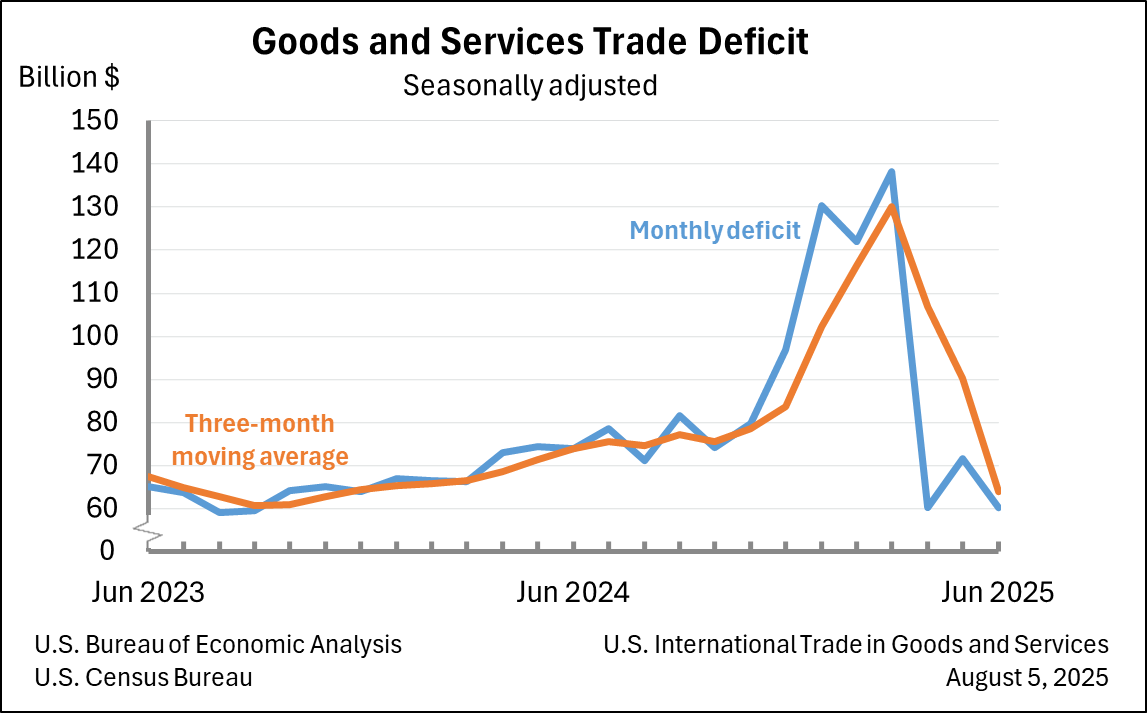Bureau of Economic Analysis
U.S. International Trade in Goods and Services, June 2025
The U.S. goods and services trade deficit decreased in June 2025 according to the U.S. Bureau of Economic Analysis and the U.S. Census Bureau. The deficit decreased from $71.7 billion in May (revised) to $60.2 billion in June, as exports decreased less than imports. The goods deficit decreased $11.4 billion in June to $85.9 billion. The services surplus increased $0.1 billion in June to $25.7 billion.
Principal Federal Economic Indicators
Noteworthy
- 2025 News Release Schedule
- Innovation at BEA
- 2025 Annual Updates
- New! Services Trade Data for More Countries
- Data Tool: Trade in Value Added
- Distribution of State Personal Income
- Updated: RIMS II Regional Multipliers
- Arts and Culture
- Space Economy
- FDI Now in State BEARFACTS
- Quick Guide: Price Indexes
The Latest
Personal Income and Outlays, September 2016
Personal income increased $46.7 billion (0.3 percent) in September according to estimates released today by the Bureau of Economic Analysis. Disposable personal income (DPI) increased $37.0 billion (0.3 percent) and personal consumption expenditures (PCE) increased $61.0 billion (0.5 percent). Real DPI increased less than 0.1 percent in September and Real PCE increased 0.3 percent. The PCE price index increased 0.2 percent.
GDP Increases in Third Quarter
Real gross domestic product (GDP) increased 2.9 percent in the third quarter of 2016, according to the “advance” estimate released by the Bureau of Economic Analysis. In the second quarter, real GDP rose 1.4 percent.
Gross Domestic Product, 3rd quarter 2016 (advance estimate)
Real gross domestic product increased at an annual rate of 2.9 percent in the third quarter of 2016 (table 1), according to the "advance" estimate released by the Bureau of Economic Analysis. In the second quarter, real GDP increased 1.4 percent. The Bureau emphasized that the third-quarter advance estimate released today is based on source data that are incomplete or subject to further revision by the source agency (see “Source Data for the…
Learn How BEA's Regional Statistics are Used to Distribute Federal Funds to State and Local Governments
Did you know that each year BEA regional economic statistics, such as annual personal income and per capita personal income are used to allocate billions of dollars in federal funds to states and local governments? In fiscal year 2015, nearly $400 billion in federal funds were distributed under programs using BEA statistics in federal funding formulas.
Expanded Geographic Detail on International Trade in Services Coming Soon
How much do U.S. residents spend on travel to Greece? How much does the U.S. export in movies and television programming to Vietnam? You can answer these questions next week when the Bureau of Economic Analysis expands the geographic detail it publishes on U.S. imports and exports of services. On October 24, we will publish annual statistics on international trade in services with 90 countries and areas, up from 49.
County GDP Stats Would Give a Closer Look at Local Economies
Anyone interested in economic growth in, let’s say, West Virginia can check state GDP data from the U.S. Bureau of Economic Analysis. Want to zoom in on a metro area, such as Charleston, W.Va., and its surroundings? BEA has gross domestic product by metropolitan areas, too.
August 2016 Trade Gap is $40.7 Billion
The U.S. monthly international trade deficit increased in August 2016 according to the U.S. Bureau of Economic Analysis and the U.S. Census Bureau. The deficit increased from $39.5 billion in July (revised) to $40.7 billion in August, as imports increased more than exports. The previously published July deficit was $39.5 billion. The goods deficit decreased less than $0.1 billion in August to $60.3 billion. The services surplus decreased $1.2…
U.S. International Trade in Goods and Services, August 2016
U.S. Census Bureau U.S. Bureau of Economic Analysis NEWS U.S. Department of Commerce * Washington, DC 20230 U.S. INTERNATIONAL TRADE IN GOODS AND SERVICES August 2016 The U.S. Census Bureau and the U.S. Bureau of Economic Analysis, through the Department of Commerce, announced today that the goods and services deficit was $40.7 billion in August, up $1.2 billion from $39.5 billion in July,…
Personal Consumption Expenditures by State, 2015
Growth in state personal consumption expenditures (PCE) – the measure of goods and services purchased by or on behalf of households – decelerated to 3.6 percent in 2015 from 4.4 percent in 2014. In 2015, growth in PCE was largely concentrated in the Far West and Rocky Mountain regions.
Personal Consumption Expenditures by State, 2015
Growth in state personal consumption expenditures (PCE) – the measure of goods and services purchased by or on behalf of households – decelerated to 3.6 percent on average in 2015 from 4.4 percent in 2014 (Table 1), according to statistics released today by the Bureau of Economic Analysis. In 2015, PCE growth ranged from 1.5 percent in Wyoming to 5.0 percent in Florida.




